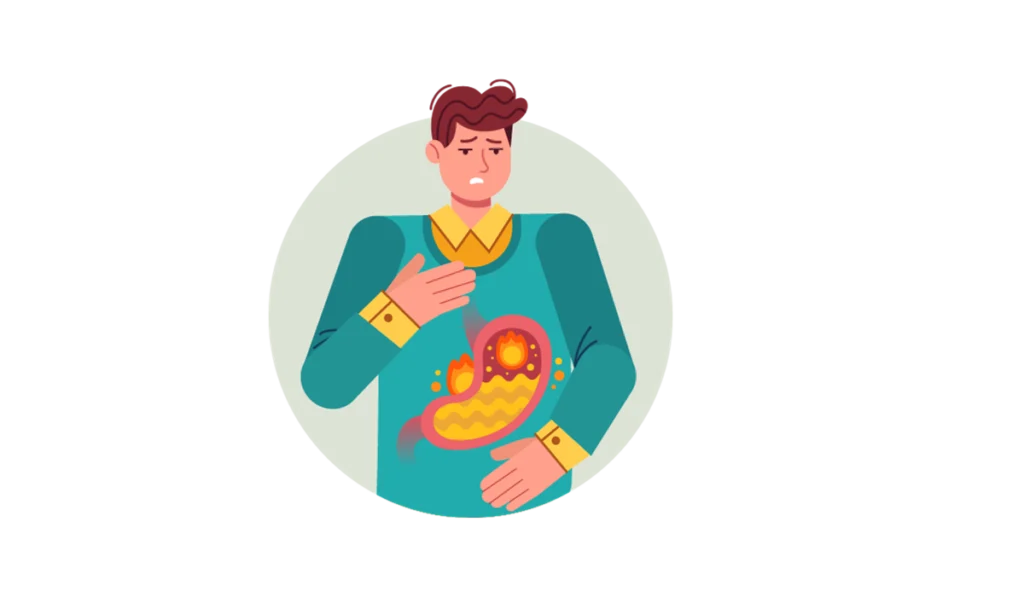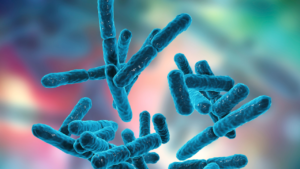Secrets of Functional Dyspepsia: When Digestion Goes Awry
Unlock the mysteries of functional dyspepsia with our guide. Learn the triggers & innovative management strategies for digestive harmony

Digesting a meal activates sensory signals in our gut, from fullness to nutrient detection.
This "gut talk" informs the brain, managing hunger and digestion.
However, in conditions like functional dyspepsia, these signals misfire, causing discomfort like nausea.
This spotlight examines how our gut-brain chat governs appetite and why it sometimes goes awry.
In This Article:
Key Points
- Our digestive system not only processes food but also senses the amount and type of food, and communicates this information to the brain through a network of nerves, including the vagus nerve.
- The vagus nerve plays a role in managing discomfort and pain in the gut, such as in conditions like functional dyspepsia.
- Disruption of the balance between vagal afferents and hormones that regulate them can lead to digestive problems such as functional dyspepsia, a condition characterized by discomfort and impaired digestion.
- Functional dyspepsia affects about 1 in 5 people and can cause symptoms like feeling full sooner than expected stomach discomfort, and slower stomach emptying.
- The article also explores the connection between functional dyspepsia and heartburn or reflux disease.
- More research is needed to understand the signals that go awry in the stomach's nerves and develop new treatments for functional dyspepsia.
- Epigastric pain syndrome and postprandial distress syndrome are subtypes of functional dyspepsia.
- Hormones like acyl ghrelin and nesfatin-1 play a complex role in EPS and PDS.
- The overactivity of hormones like CCK in PDS is discussed, as well as the amplified response of vagal afferents to mechanical and chemical stimuli in EPS.
Gut Feelings: The Science Behind Tummy Troubles
When we eat, our digestive system doesn't just process food.
It senses what's coming in, from the amount to the type.
But sometimes, this system can be a bit too sensitive, leading to issues like functional dyspepsia, where eating becomes uncomfortable or painful A Trusted Source Feinle-Bisset, C. (2016). Upper gastrointestinal sensitivity to meal-related signals in adult humans—relevance to appetite regulation and gut symptoms in health, obesity and functional dyspepsia. Physiol. Behav. 162, 69–82. doi: 10.1016/j.physbeh.2016.03.021PubMed AbstractCrossRef Full TextGoogle Scholar .

Our gut talks to our brain through a network of nerves, making us feel full or nauseous.
While pain has been mostly linked to spinal nerves, there's growing evidence that the vagus nerve, which runs from the brain to the gut, also helps manage the discomfort we feel A Trusted Source Holtmann, G., Goebell, H., Jockenhoevel, F., and Talley, N. J. (1998). Altered vagal and intestinal mechanosensory function in chronic unexplained dyspepsia. Gut 42, 501–506. doi: 10.1136/gut.42.4.501PubMed AbstractCrossRef Full TextGoogle Scholar A Trusted Source Wang, E. M., Li, W. T., Yan, X. J., Chen, X., Liu, Q., Feng, C. C., et al. (2015). Vagal afferent-dependent cholecystokinin modulation of visceral pain requires central amygdala NMDA-NR2B receptors in rats. Neurogastroenterol. Motil. 27, 1333–1343. doi: 10.1111/nmo.12633PubMed AbstractCrossRef Full TextGoogle Scholar.
This overview will shed light on how this nerve might be responsible for the pain associated with functional dyspepsia.
The Vagus Nerve: Your Gut's Sensory Superhighway
Did you know the vagus nerve is like a two-way street, sending signals between your gut and brain? It's not just one type of nerve either.
Originating from different parts of an embryo, some of these nerves, called vagal afferents, are thought to help sense discomfort in the gut, much like how we detect pain elsewhere A Trusted Source Yu, S., Undem, B. J., and Kollarik, M. (2005). Vagal afferent nerves with nociceptive properties in guinea-pig oesophagus. J. Physiol. 563, 831–842. doi: 10.1113/jphysiol.2004.079574 PubMed AbstractCrossRef Full TextGoogle Scholar.
These vagal nerve endings in our gut come in three main types.
One kind spreads through the muscle layers of the gut, possibly acting like stretch sensors A Trusted Source Berthoud, H. R., and Powley, T. L. (1992). Vagal afferent innervation of the rat fundic stomach: morphological characterization of the gastric tension receptor. J. Comp. Neurol. 319, 261–276. doi: 10.1002/cne.903190206 PubMed AbstractCrossRef Full TextGoogle Scholar A Trusted Source Phillips, R. J., Baronowsky, E. A., and Powley, T. L. (1997). Afferent innervation of gastrointestinal tract smooth muscle by the hepatic branch of the vagus. J. Comp. Neurol. 384, 248–270. doi: 10.1002/(sici)1096-9861(19970728)384:2<248::aid-cne6>3.3.co;2- fPubMed AbstractCrossRef Full TextGoogle Scholar, although scientists are still figuring out exactly how they work.
Another type nests between those muscle layers, where it might sense how the gut squeezes and stretches A Trusted Source Zagorodnyuk, V. P., Chen, B. N., and Brookes, S. J. H. (2001). Intraganglionic laminar endings are mechano-transduction sites of vagal tension receptors in the guinea-pig stomach. J. Physiol. 534, 255–268. doi: 10.1111/j.1469-7793.2001.00255.x PubMed AbstractCrossRef Full TextGoogle Scholar.
The third type sits in the gut lining, ready to pick up on the slightest touch or the chemicals in the food we eat A Trusted Source Page, A. J., Martin, C. M., and Blackshaw, L. A. (2002). Vagal mechanoreceptors and chemoreceptors in mouse stomach and esophagus. J. Neurophysiol. 87, 2095–2103. doi: 10.1152/jn.00785.2001 PubMed AbstractCrossRef Full TextGoogle Scholar.
These nerves are pretty smart—they can tell the difference between various sensations in different parts of the gut.
For example, they notice when your stomach is full or when your intestines pick up nutrients from your food.
All these messages travel up the vagus nerve to a part of the brain called the nucleus tractus solitarius.
Here, your brain takes the information, mixes it with other signals, and coordinates how your gut moves, how it empties, and even how full you feel A Trusted Source Berthoud, H. R., Blackshaw, L. A., Brookes, S. J. H., and Grundy, D. (2004). Neuroanatomy of extrinsic afferents supplying the gastrointestinal tract. Neurogastroenterol. Motil. 16, 28–33. doi: 10.1111/j.1743-3150.2004.00471.x PubMed AbstractCrossRef Full TextGoogle Scholar A Trusted Source Brookes, S. J., Spencer, N. J., Costa, M., and Zagorodnyuk, V. P. (2013). Extrinsic primary afferent signalling in the gut. Nat. Rev. Gastroenterol. Hepatol. 10, 286–296. doi: 10.1038/nrgastro.2013.29 PubMed AbstractCrossRef Full TextGoogle Scholar.
Isn't it fascinating how your body has its own internal communication system?
Navigating the Signals of Satiety: The Role of Vagal Afferents
Have you ever wondered how your body knows when you're full, or how it manages what you've eaten?

Behind the scenes, a network of nerves called vagal afferents orchestrates this complex process, signaling from your gut to your brain.
Let's explore how this fascinating communication system plays a key role in our digestion and feelings of satiety.
The Two Stomach Sentinels
Within the walls of your stomach lie two types of sensors, each with its own role in monitoring the progress of your meal.
The 'mucosal receptors' act as the first alert system.
They are quite sensitive, reacting to even light touches, and are thought to be involved in determining the size of chewed food, triggering feelings of nausea or fullness A Trusted Source Tuleu, C., Andrieux, C., Boy, P., and Chaumeil, J. C. (1999). Gastrointestinal transit of pellets in rats: effect of size and density. Int. J. Pharm. 180, 123–131. doi: 10.1016/s0378-5173(98)00400-1PubMed AbstractCrossRef Full TextGoogle Scholar, and possibly even regulating the pace at which our stomach empties itself.
The second type, 'tension receptors,' are the guardians of gastric stretch.
These receptors track the expansion of the stomach, providing real-time feedback to the brain on how full we are, aiding in controlling our food intake and the muscular contractions of our GI tract A Trusted Source Page, A. J., and Blackshaw, L. A. (1998). An in vitro study of the properties of vagal afferent fibres innervating the ferret oesophagus and stomach. J. Physiol. 512, 907–916. doi: 10.1111/j.1469-7793.1998.907bd.x PubMed AbstractCrossRef Full TextGoogle Scholar A Trusted Source Page, A. J., Martin, C. M., and Blackshaw, L. A. (2002). Vagal mechanoreceptors and chemoreceptors in mouse stomach and esophagus. J. Neurophysiol. 87, 2095–2103. doi: 10.1152/jn.00785.2001 PubMed AbstractCrossRef Full TextGoogle Scholar.
Hormonal Harmony
Our gut also houses specialized cells that release various hormones in response to the nutrients we consume.
These hormones, like cholecystokinin (CCK), GLP-1, and peptide YY (PYY), play pivotal roles in signaling our brain about fullness and regulating the movement of food through the intestines.
CCK, released when we eat fats or certain proteins, acts as a satiety signal and is key to controlling appetite A Trusted Source Gibbs, J., Young, R. C., and Smith, G. P. (1973). Cholecystokinin elicits satiety in rats with open gastric fistulas. Nature 245, 323–325. doi: 10.1038/245323a0 PubMed AbstractCrossRef Full TextGoogle Scholar A Trusted Source Hewson, G., Leighton, G. E., Hill, R. G., and Hughes, J. (1988). The cholecystokinin receptor antagonist L364,718 increases food intake in the rat by attenuation of the action of endogenous cholecystokinin. Br. J. Pharmacol. 93, 79–84. doi: 10.1111/j.1476-5381.1988.tb11407.x PubMed AbstractCrossRef Full TextGoogle Scholar.
GLP-1 and PYY also contribute to this feeling of fullness.
GLP-1 even goes further by aiding in insulin release and slowing down food's journey through the stomach A Trusted Source Drucker, D. J. (2006). The biology of incretin hormones. Cell Metab. 3, 153–165. doi: 10.1016/j.cmet.2006.01.004 PubMed AbstractCrossRef Full TextGoogle Scholar .
These hormones effectively ensure that we don't overeat and help manage the digestive process.
A Delicate Balance
This system of vagal afferents and the hormones that regulate them is finely tuned.
However, it's also delicate—any disruption can lead to digestive problems such as functional dyspepsia, a condition characterized by discomfort and impaired digestion.
By appreciating the subtle yet sophisticated ways our body manages food intake and digestion, we're reminded of the intricate balance our bodies maintain every day.
The discovery of these mechanisms A Trusted Source Berthoud, H.-R., and Neuhuber, W. L. (2000). Functional and chemical anatomy of the afferent vagal system. Auton. Neurosci. 85, 1–17. doi: 10.1016/s1566-0702(00)00215-0 PubMed AbstractCrossRef Full TextGoogle Scholar A Trusted Source Andrews, P. L. R., and Sanger, G. J. (2002). Abdominal vagal afferent neurones: an important target for the treatment of gastrointestinal dysfunction. Curr. Opin. Pharmacol. 2, 650–656. doi: 10.1016/s1471-4892(02)00227-8 PubMed AbstractCrossRef Full TextGoogle Scholar sheds light on the importance of a well-functioning digestive system for our overall well-being.
Understanding these signals can help us make better choices about our diet and health, ensuring that the conversation between gut and brain continues smoothly.
Understanding the Discomfort of Functional Dyspepsia
Functional dyspepsia (FD) is a common gastrointestinal condition, affecting about 1 in 5 people, that can make eating an uncomfortable experience without any clear medical explanation A Trusted Source Tack, J., Talley, N. J., Camilleri, M., Holtmann, G., Hu, P., Malagelada, J. R., et al. (2006). Functional gastroduodenal disorders. Gastroenterology 130, 1466–1479. doi: 10.1053/j.gastro.2005.11.059 PubMed AbstractCrossRef Full TextGoogle Scholar.
Imagine sitting down to a meal and feeling full much sooner than expected, or experiencing discomfort in your stomach that just doesn't seem to go away.

This is the reality for those with FD, where a typical meal can lead to exaggerated discomfort A Trusted Source Bisschops, R., Karamanolis, G., Arts, J., Caenepeel, P., Verbeke, K., Janssens, J., et al. (2008). Relationship between symptoms and ingestion of a meal in functional dyspepsia. Gut 57, 1495–1503. doi: 10.1136/gut.2007.137125 PubMed AbstractCrossRef Full TextGoogle Scholar.
What's puzzling for doctors and scientists alike is that this heightened sensitivity in the stomach doesn't have a clear cause.
Yet, it's not just about sensitivity; FD can also involve a slower process of stomach emptying and a reduced ability for the stomach to stretch and accommodate food A Trusted Source Tack, J., Piessevaux, H., Coulie, B., Caenepeel, P., and Janssens, J. (1998). Role of impaired gastric accommodation to a meal in functional dyspepsia. Gastroenterology 115, 1346–1352. doi: 10.1016/s0016-5085(98)70012-5 PubMed AbstractCrossRef Full TextGoogle Scholar A Trusted Source Sarnelli, G., Caenepeel, P., Geypens, B., Janssens, J., and Tack, J. (2003). Symptoms associated with impaired gastric emptying of solids and liquids in functional dyspepsia. Am. J. Gastroenterol. 98, 783–788. doi: 10.1016/s0002-9270(03)00053-4 PubMed AbstractCrossRef Full TextGoogle Scholar.
Interestingly, there's also a connection between FD and heartburn or reflux disease, possibly due to similar disturbances in the nerve signals from the stomach A Trusted Source Pauwels, A., Altan, E., and Tack, J. (2014). The gastric accommodation response to meal intake determines the occurrence of transient lower esophageal sphincter relaxations and reflux events in patients with gastro-esophageal reflux disease. Neurogastroenterol. Motil. 26, 581–588. doi: 10.1111/nmo.12305 PubMed AbstractCrossRef Full TextGoogle Scholar.
A particular area of interest is a type of protein called the TRPV1 channel, which responds to heat, acidity, and even spicy foods like chilli peppers A Trusted Source Tominaga, M., Caterina, M. J., Malmberg, A. B., Rosen, T. A., Gilbert, H., Skinner, K., et al. (1998). The cloned capsaicin receptor integrates multiple pain-producing stimuli. Neuron 21, 531–543. doi: 10.1016/s0896-6273(00)80564-4 PubMed AbstractCrossRef Full TextGoogle Scholar A Trusted Source Caterina, M. J., Schumacher, M. A., Tominaga, M., Rosen, T. A., Levine, J. D., and Julius, D. (1997). The capsaicin receptor: a heat-activated ion channel in the pain pathway. Nature 389, 816–824. doi: 10.1038/39807 PubMed AbstractCrossRef Full TextGoogle Scholar.
Found in the nerves that carry signals from the stomach, these channels help tell our brain when we're full A Trusted Source Kentish, S. J., Frisby, C. L., Kritas, S., Li, H., Hatzinikolas, G., O’Donnell, T. A., et al. (2015). TRPV1 channels and gastric vagal afferent signalling in lean and high fat diet induced obese mice. PLoS One 10:e0135892. doi: 10.1371/journal.pone.0135892 PubMed AbstractCrossRef Full TextGoogle Scholar.
However, in FD, there could be an oversensitivity to these signals, especially to spicy components like capsaicin A Trusted Source Lee, S. Y., Masaoka, T., Han, H. S., Matsuzaki, J., Hong, M. J., Fukuhara, S., et al. (2016). A prospective study on symptom generation according to spicy food intake and TRPV1 genotypes in functional dyspepsia patients. Neurogastroenterol. Motil. 28, 1401–1408. doi: 10.1111/nmo.12841PubMed AbstractCrossRef Full TextGoogle Scholar, leading to that feeling of fullness or pain.
While this might shed some light on the discomfort experienced, the full picture of FD is still unclear, partly because we haven't studied it as thoroughly as other similar conditions like irritable bowel syndrome.
This is due, in part, to the lack of animal models that accurately represent FD, which makes it challenging to uncover the root causes of the condition A Trusted Source Tack, J., Talley, N. J., Camilleri, M., Holtmann, G., Hu, P., Malagelada, J. R., et al. (2006). Functional gastroduodenal disorders. Gastroenterology 130, 1466–1479. doi: 10.1053/j.gastro.2005.11.059 PubMed AbstractCrossRef Full TextGoogle Scholar.
FD is a complex condition with two main subtypes, each with its own set of symptoms.
Unraveling its mysteries requires more research to understand the signals that go awry in the stomach's nerves.
With better knowledge, perhaps new treatments can emerge to help those affected by this perplexing and often overlooked condition.
Decoding the Discomfort: Understanding Epigastric Pain Syndrome and Postprandial Distress
Have you ever experienced a burning sensation in your upper stomach or felt uncomfortably full after eating just a small amount of food? If so, you may be familiar with conditions like Epigastric Pain Syndrome (EPS) and Postprandial Distress Syndrome (PDS), which fall under the umbrella of functional dyspepsia.
Insights into Postprandial Distress Syndrome
For many, the simple joy of a meal can be marred by an immediate sense of uncomfortable fullness, bloating, or nausea.
This is the world of those living with postprandial distress syndrome (PDS), a subtype of functional dyspepsia that makes dining a distressing experience.
Key to understanding PDS is recognizing how our stomach's sensitivity plays a crucial role in these symptoms.
In approximately 30%–40% of individuals with functional dyspepsia, there is an unusual hypersensitivity to the stretching of the stomach as it fills A Trusted Source Tack, J., Caenepeel, P., Fischler, B., Piessevaux, H., and Janssens, J. (2001). Symptoms associated with hypersensitivity to gastric distention in functional dyspepsia. Gastroenterology 121, 526–535. doi: 10.1053/gast.2001.27180PubMed AbstractCrossRef Full TextGoogle Scholar A Trusted Source Boeckxstaens, G. E., Hirsch, D. P., Kuiken, S. D., Heisterkamp, S. H., and Tytgat, G. N. (2002). The proximal stomach and postprandial symptoms in functional dyspeptics. Am. J. Gastroenterol. 97, 40–48. doi: 10.1016/s0002-9270(01)03983-1PubMed AbstractCrossRef Full TextGoogle Scholar.
This heightened sensitivity can explain the premature fullness and difficulty in finishing meals that those with PDS experience.
Moreover, it's not just physical expansion but also the nutrients—particularly fats—that can trigger symptoms.
Studies show that when individuals with PDS receive a fatty infusion in the duodenum, they report more intense feelings of fullness and discomfort compared to healthy people (Barbera et al., 1995b).
A deeper dive into the science reveals that certain gut hormones, such as cholecystokinin (CCK), may influence these reactions.
People with PDS have been found to have higher levels of CCK, which can aggravate symptoms A Trusted Source Pilichiewicz, A. N., Feltrin, K. L., Horowitz, M., Holtmann, G., Wishart, J. M., Jones, K. L., et al. (2008). Functional dyspepsia is associated with a greater symptomatic response to fat but not carbohydrate, increased fasting and postprandial CCK and diminished PYY. Am. J. Gastroenterol. 103, 2613–2623. doi: 10.1111/j.1572-0241.2008.02041.x PubMed AbstractCrossRef Full TextGoogle Scholar.
On the flip side, blocking CCK's effects can alleviate discomfort A Trusted Source Feinle, C., Meier, O., Otto, B., D’Amato, M., and Fried, M. (2001). Role of duodenal lipid and cholecystokinin A receptors in the pathophysiology of functional dyspepsia. Gut 48, 347–355. doi: 10.1136/gut.48.3.347PubMed AbstractCrossRef Full TextGoogle Scholar, indicating its significant role in how PDS patients process fat.
Other hormones are also under scrutiny for their potential impact on PDS.
For instance, the hormone acyl ghrelin is usually less abundant in those with PDS A Trusted Source Choi, Y. J., Kim, N., Yoon, H., Shin, C. M., Park, Y. S., Park, J. H., et al. (2016). Increase in plasma acyl ghrelin levels is associated with abatement of dyspepsia following Helicobacter pylori eradication. J. Gastroenterol. 51, 548–559. doi: 10.1007/s00535-015-1124-6 PubMed AbstractCrossRef Full TextGoogle Scholar,
and this decrease is associated with slower gastric emptying and symptoms like vomiting A Trusted Source Stanghellini, V., Tosetti, C., Paternico, A., Barbara, G., Morselli-Labate, A. M., Monetti, N., et al. (1996). Risk indicators of delayed gastric emptying of solids in patients with functional dyspepsia. Gastroenterology 110, 1036–1042. doi: 10.1053/gast.1996.v110.pm8612991PubMed AbstractCrossRef Full TextGoogle Scholar.

Ghrelin's role is complex, as it can either increase or decrease how the stomach and intestines respond to being stretched, depending on the site A Trusted Source Murray, C. D. R., Booth, C. E., Bulmer, D. C. E., Kamm, M. A., Emmanuel, A. V., and Winchester, W. J. (2006). Ghrelin augments afferent response to distension in rat isolated jejunum. Neurogastroenterol. Motil. 18, 1112–1120. doi: 10.1111/j.1365-2982.2006.00848.x PubMed AbstractCrossRef Full TextGoogle Scholar A Trusted Source Page, A. J., Slattery, J. A., Milte, C., Laker, R., O’Donnell, T., Dorian, C., et al. (2007). Ghrelin selectively reduces mechanosensitivity of upper gastrointestinal vagal afferents. Am. J. Physiol. Gastrointest. Liver Physiol. 292, G1376–G1384. doi: 10.1152/ajpgi.00536.2006 PubMed AbstractCrossRef Full TextGoogle Scholar.
New research has also focused on the hormone nesfatin-1, which has been found in higher levels in stressed rats mimicking PDS conditions.
Nesfatin-1 could enhance the stomach's sensitivity to meal-related signals, potentially leading to the discomfort felt during and after eating A Trusted Source Jing, F. C., Zhang, J., Feng, C., Nian, Y. Y., Wang, J. H., Hu, H., et al. (2017). Potential rat model of anxiety-like gastric hypersensitivity induced by sequential stress. World J. Gastroenterol. 23, 7594–7608. doi: 10.3748/wjg.v23.i42.7594 PubMed AbstractCrossRef Full TextGoogle Scholar A Trusted Source Kentish, S. J., Li, H., Frisby, C. L., and Page, A. J. (2017). Nesfatin-1 modulates murine gastric vagal afferent mechanosensitivity in a nutritional state dependent manner. Peptides 89, 35–41. doi: 10.1016/j.peptides.2017.01.005 PubMed AbstractCrossRef Full TextGoogle Scholar.
While the puzzle of PDS is far from complete, what is clear is that a delicate balance of hormones and stomach sensitivity lies at the heart of the syndrome.
The interactions of hormones like CCK, ghrelin, and nesfatin-1, and possibly others such as GLP-1 and PYY A Trusted Source Pilichiewicz, A. N., Feltrin, K. L., Horowitz, M., Holtmann, G., Wishart, J. M., Jones, K. L., et al. (2008). Functional dyspepsia is associated with a greater symptomatic response to fat but not carbohydrate, increased fasting and postprandial CCK and diminished PYY. Am. J. Gastroenterol. 103, 2613–2623. doi: 10.1111/j.1572-0241.2008.02041.x PubMed AbstractCrossRef Full TextGoogle Scholar, open doors to a better understanding and, hopefully, more effective treatments for those who face the daily challenge of PDS.
A Closer Look at Epigastric Pain Syndrome
Epigastric Pain Syndrome presents itself through intermittent pain or burning in the upper stomach, occurring at least once a week A Trusted Source Malagelada, J. R. (2001). Review article: the continuing dilemma of dyspepsia. Aliment. Pharmacol. Ther. 15, 6–9. doi: 10.1046/j.1365-2036.2001.00108.x PubMed AbstractCrossRef Full Text A Trusted Source Holzer, P. (2002). Sensory neurone responses to mucosal noxae in the upper gut: relevance to mucosal integrity and gastrointestinal pain. Neurogastroenterol. Motil. 14, 459–475. doi: 10.1046/j.1365-2982.2002.00353.x PubMed AbstractCrossRef Full TextGoogle Scholar.
The discomfort experienced may stem from either increased sensitivity of gut nerves or an overreaction within the brain to normal stomach activities.
Moreover, pain could be a result of a heightened pain perception due to the cumulative effect of signals sent by the stomach to the brain A Trusted Source Accarino, A. M., Azpiroz, F., and Malagelada, J. R. (2002). Gut perception in humans is modulated by interacting gut stimuli. Am. J. Physiol. Gastrointest. Liver Physiol. 282, G220–G225. doi: 10.1152/ajpgi.00161.2001 PubMed AbstractCrossRef Full TextGoogle Scholar.
Contrary to earlier beliefs, recent studies highlight the role of vagal afferents—nerves that convey information from the stomach to the brain—in the sensation of visceral pain.
Interestingly, certain gastric afferents may transmit signals only when subjected to high pressure, possibly contributing to the discomfort in EPS A Trusted Source Yu, S., Undem, B. J., and Kollarik, M. (2005). Vagal afferent nerves with nociceptive properties in guinea-pig oesophagus. J. Physiol. 563, 831–842. doi: 10.1113/jphysiol.2004.079574 PubMed AbstractCrossRef Full TextGoogle Scholar A Trusted Source Ozaki, N., Sengupta, J. N., and Gebhart, G. F. (1999). Mechanosensitive properties of gastric vagal afferent fibers in the rat. J. Neurophysiol. 82, 2210–2220. doi: 10.1152/jn.1999.82.5.2210 PubMed AbstractCrossRef Full TextGoogle Scholar.
Gastric Acid: A Potential Pain Trigger
While gastric acid is commonly implicated in conditions like GERD and ulcers, it might also sensitize stomach nerves, contributing to the pain associated with functional dyspepsia, despite normal acid levels in such patients A Trusted Source Kang, J. Y., Yap, I., Guan, R., and Tay, H. H. (1986). Acid perfusion of duodenal ulcer craters and ulcer pain: a controlled double blind study. Gut 27, 942–945. doi: 10.1136/gut.27.8.942 PubMed AbstractCrossRef Full TextGoogle Scholar A Trusted Source Collen, M. J., and Loebenberg, M. J. (1989). Basal gastric acid secretion in nonulcer dyspepsia with or without duodenitis. Dig. Dis. Sci. 34, 246–250. doi: 10.1007/bf01536059 PubMed AbstractCrossRef Full TextGoogle Scholar.

This pain does not seem to be processed in the same way as typical pain sensations, instead influencing areas of the brain responsible for emotional and stress responses A Trusted Source Michl, T., Jocic, M., Heinemann, A., Schuligoi, R., and Holzer, P. (2001). Vagal afferent signaling of a gastric mucosal acid insult to medullary, pontine, thalamic, hypothalamic and limbic, but not cortical, nuclei of the rat brain. Pain 92, 19–27. doi: 10.1016/s0304-3959(00)00467-x PubMed AbstractCrossRef Full TextGoogle Scholar.
The Complex Role of Gut Hormones In PDS, key hormones like CCK (cholecystokinin) have been found to be overactive.
CCK can exacerbate symptoms like bloating and nausea, as it makes the stomach and intestines overly responsive to the stretch caused by food A Trusted Source Pilichiewicz, A. N., Feltrin, K. L., Horowitz, M., Holtmann, G., Wishart, J. M., Jones, K. L., et al. (2008). Functional dyspepsia is associated with a greater symptomatic response to fat but not carbohydrate, increased fasting and postprandial CCK and diminished PYY. Am. J. Gastroenterol. 103, 2613–2623. doi: 10.1111/j.1572-0241.2008.02041.x PubMed AbstractCrossRef Full TextGoogle Scholar.
Conversely, another hormone, ghrelin, might have a mixed role; its decreased levels have been linked to slowed stomach emptying and symptoms like fullness and vomiting A Trusted Source Choi, Y. J., Kim, N., Yoon, H., Shin, C. M., Park, Y. S., Park, J. H., et al. (2016). Increase in plasma acyl ghrelin levels is associated with abatement of dyspepsia following Helicobacter pylori eradication. J. Gastroenterol. 51, 548–559. doi: 10.1007/s00535-015-1124-6 PubMed AbstractCrossRef Full TextGoogle Scholar.
It’s evident that hormones are central to the development of symptoms in PDS but how they interact with the nervous system still requires further research.
The pain experienced in EPS might not be due just to local stomach changes, but also to an enhanced response of vagal afferents to mechanical and chemical stimuli.
This means that the signals sent to the brain are amplified, potentially causing an exaggerated pain response A Trusted Source Feinle, C., Meier, O., Otto, B., D’Amato, M., and Fried, M. (2001). Role of duodenal lipid and cholecystokinin A receptors in the pathophysiology of functional dyspepsia. Gut 48, 347–355. doi: 10.1136/gut.48.3.347 PubMed AbstractCrossRef Full TextGoogle Scholar.
To sum up, our understanding of conditions like EPS and PDS has evolved.
We now know that the vagal afferents, once thought to be bystanders in pain sensation, are actually key players in how we experience gastrointestinal discomfort.
These afferents not only manage the body's basic responses to food but can also influence pain perception in functional dyspepsia.
However, more research is needed to fully understand their role and pave the way for more effective treatments.
While the journey to fully grasp these complex mechanisms continues, what is clear is that the intricate interplay between the gut, its hormones, and the nervous system is fundamental to the experience of pain and discomfort in gastrointestinal disorders.
Discussion and Conclusion
- The article explores the connection between the gut and the brain, highlighting the role of the vagus nerve in transmitting signals related to discomfort and pain in conditions like functional dyspepsia.
- Hormones play a crucial role in regulating appetite and digestion, and disruption in the balance between vagal afferents and these hormones can lead to digestive problems.
- Functional dyspepsia is a common condition characterized by discomfort, impaired digestion, and symptoms like feeling full sooner than expected and slower stomach emptying.
- The article discusses subtypes of functional dyspepsia, such as postprandial distress syndrome (PDS) and epigastric pain syndrome (EPS), and their specific symptoms and causes.
- More research is needed to understand the signals that go awry in the stomach's nerves and develop effective treatments for functional dyspepsia.
- The complex role of hormones like acyl ghrelin and nesfatin-1 in EPS and PDS is highlighted, along with the overactivity of hormones like CCK in PDS and amplified response of vagal afferents in EPS.
- Overall, understanding the intricate connection between the gut and the brain is important for managing digestive disorders and maintaining overall well-being.
Review date not set.
How we reviewed this article:
Latest on:





